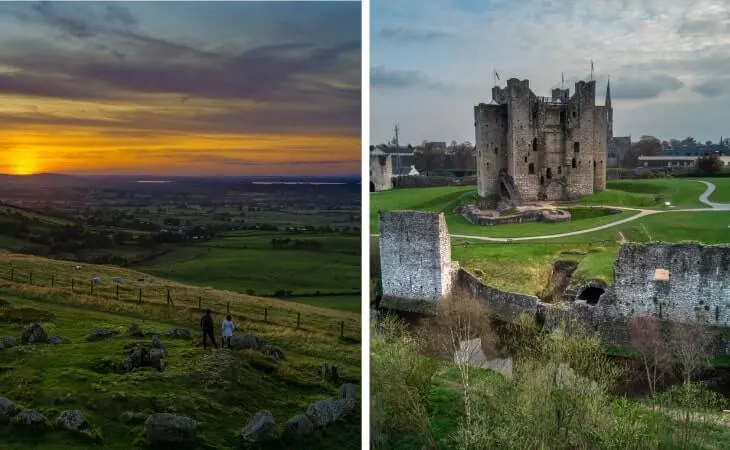The Boyne Valley Drive takes you to many of the best places to visit in Meath along with many of the top attractions in Louth.
The route immerses you in 5,000 years of history, and is home to heavyweights like Newgrange, the Hill of Tara and Loughcrew.
Although you can do the drive in a day, you’ll need 2-3 if you want to tackle the many walks and tours.
In the guide below, you’ll find a route to follow for the Boyne Valley Drive along with plenty to see and do along the way.
Some quick need-to-knows about the Boyne Valley Drive

Photos via Shutterstock
So, the Boyne Valley Drive is straight-forwardish, once you have a rough idea of the route you’re going to follow. However, there’s several need-to-knows.
1. What it’s all about
The Boyne Valley is an area steeped in history and mythology. This region encompasses County Meath and the south of County Louth. Along the way, you will discover breath-taking landscapes, the bustling River Boyne and seemingly endless ancient sites that have many a tale to tell.
2. 5,000 years of history
The Boyne Valley has been inhabited for a staggering 5,000 years and those that have called it home left many artefacts and monuments behind, many of which still stand to this day. In a nutshell, there’s endless historical sites waiting to be explored.
3. How long it takes
If you’re stuck for time, you could visit the main attractions on the Boyne Valley Drive over the course of a day. However, try to give yourself 2, as there’s lots of walks and tours to head off on.
4. Where it starts and ends
The beauty of the Boyne Valley Drive is that you can start if wherever you like, once you have a good gist of the different stops. We’ve made a Google Map with the different points-of-interest below.
Our Boyne Valley Drive road trip
So, you can tackle the Boyne Valley Drive however you like – the map above and the order of the places below just show how we’d tackle it.
You can also leave out certain places/things to do if they don’t tickle your fancy. We’ve included a mix of walks, tours and ancient sites, to give you a sense of what’s on offer.
Below, you’ll find some info on each of the areas plotted on the map above, starting with a nice ramble and finishing with the brilliant Brú na Bóinne.
Stop 1: Balrath Woods
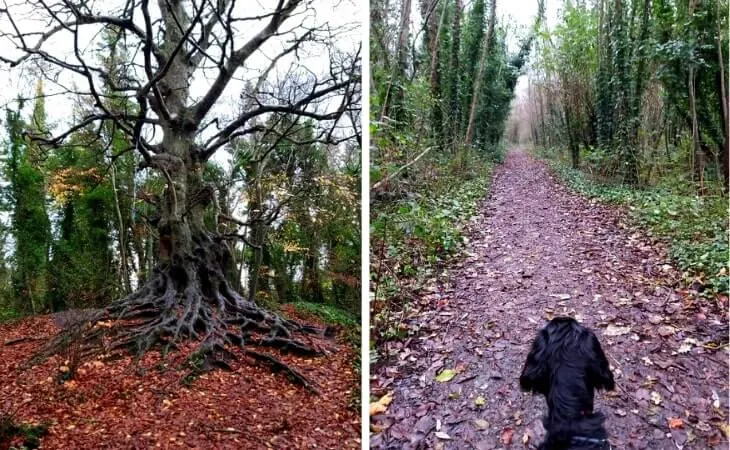
Photos courtesy of Niall Quinn
Balrath Woods is home to one of my favourite walks in Meath. Here you will find three defined trails; the long walk, circling the perimeter of the forest, the easy walk, suitable for wheelchairs, and the nature walk.
As you ramble along the route, keep an eye out for small mammals such as foxes, hares, badgers and plenty of birds, such as the colourful chaffinches, robins and wrens.
This place can get very muddy, so make sure to bring a pair of walking boots with you, if you can.
Stop 2: Skryne

Photos by Adam.Bialek(Shutterstock)
The tiny village of Skryne is situated where the N2 and N3 national roads meet, and it’s a short 8-minute drive from Balrath Woods (stop 1). Despite being small, this little village has a lot to offer!
The main attraction is the 15th-century church situated on the top of Skryne Hill, known as Skryne Tower. This structure is still in good condition and from here you will have a wonderful view of the surrounding countryside.
At the foot of the tower, you will also find a pub (O’Connell’s) famously known for being the setting of the Guinness ‘White Christmas’ ad.
Stop 3: The Hill of Tara
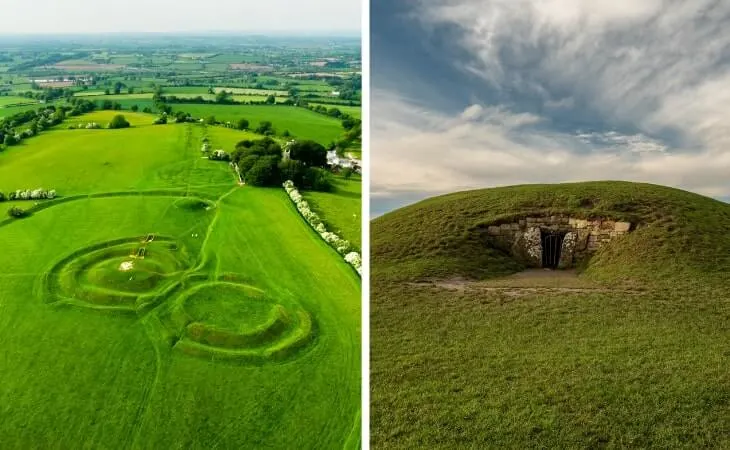
Photos via Shutterstock
You’ll find our next stop, the Hill of Tara, an 8-minute drive from Skryne. There’s a car park next to it and a shop where you can grab an ice cream, if you like!
This ancient ceremonial and burial site is particularly important in Irish mythology as this was the inauguration place and seat for the High King of Ireland.
The Hill of Tara is home to several monuments, such as passage tombs and burial mounds, dating back to the Neolithic and Iron Age.
Stop 4: Bective Abbey
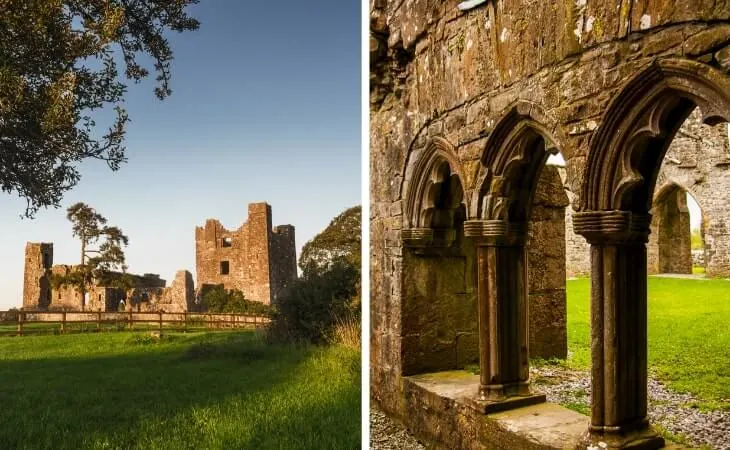
Photos via Shutterstock
Our next stop, Bective Abbey, is a 10-minute spin from the Hill of Tara. It’s here that you’ll find Ireland’s second Cistercian Abbey.
It was originally built in 1147, however, most of what remains nowadays dates from the 13th and 15th centuries.
The most impressive feature of the abbey is its particularly well-preserved cloister, featuring gothic arches that were commonly used in Cistercian architecture.
Stop 5: Trim

Photos via Shutterstock
Next up, the picturesque town of Trim, is a handy 8-minute drive from Bective Abbey. This town is particularly known for the wonderful Trim Castle.
This is the largest Anglo-Norman fortification in the whole of Ireland and dates back to 1220! But there’s more to this town than just its castle.
See our guide to the best things to do in Trim to see what else the town has to offer (or our Trim restaurants guide if you’re feeling peckish!).
Stop 6: The Hill of Ward
The Hill of Ward is a short, 15-minute drive in Trim. This is an important prehistoric site that was used for rituals in ancient times. It consists of a quadrivallate enclosure comprising four ditches and banks.
During the Middle Age, the Hill of Ward was used as a site for festivals including the precursor of our modern Halloween.
This site is also important in Irish mythology as it was the location where the Celtic Goddess Tlachtga gave birth to her triplets. For this reason, the Hill of Ward is often referred to as the Hill of Tlachtga.
Stop 7: Loughcrew
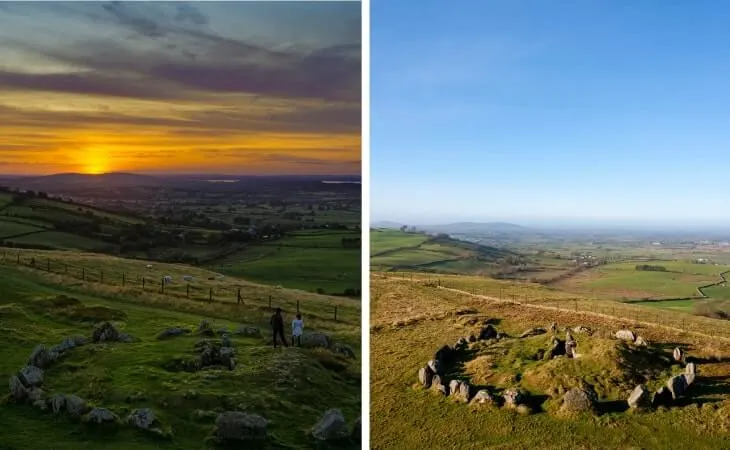
Photos via Shutterstock
Our next stop, Loughcrew Cairns is a 30-minute spin from the Hill of Ward. It’s here that you’ll discover a group of passage tombs dating back to 3,000 BC.
Cairn T is the most visited one and it consists of a cruciform chamber, a corbelled roof and carved stones from the Neolithic period.
History aside, the big attraction here is the view – this is the highest hill in Meath and, on a clear day, the views are sensational.
Stop 8: Kells Monastic Site
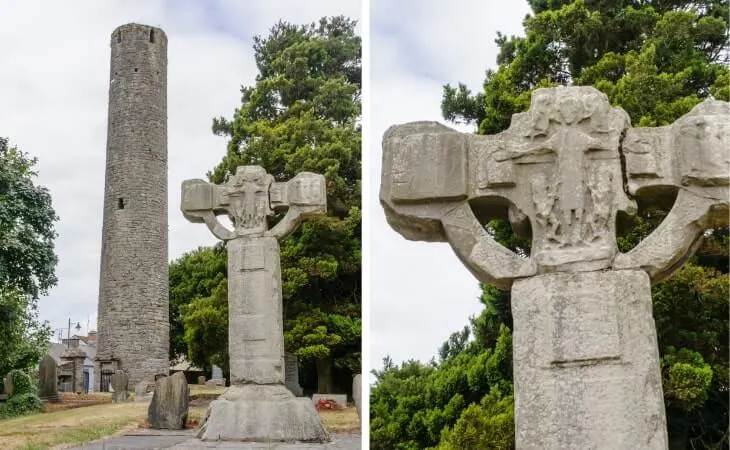
Photos via Shutterstock
Next up is Kells – a 20-minute drive from our last stop! When you arrive, head off in the direction of St Columba’s Church.
The present church was built in 1778 and then altered in 1811 and 1858. Outside of the church, you will find four Celtic crosses dating back to the 11th century.
Next to them, the Kells Round Tower stands proud. It was built around the 11th century with the purpose of providing shelters to the monks during invasions.
Stop 9: The Spire of Lloyd
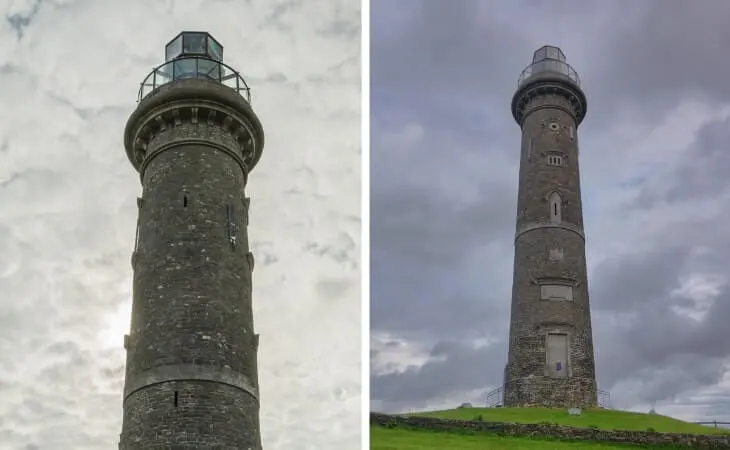
Photos via Shutterstock
The Spire of Lloyd is a a short 5-minute spin from Kells, and it’s one of the most unique places to visit in Meath.
Seen from miles around, the Spire towers into the County Meath sky, casting its shadow over the landscape it silently watches.
The Spire is Ireland’s only inland lighthouse and it’s only open to the public on Bank Holiday Mondays.
Stop 10: Donaghpatrick Church

Photo by Babetts Bildergalerie (Shutterstock)
Donaghpatrick Church is a 15-minute drive from the Spire of Lloyd. This church is a wonderful example of the Hiberno-Romanesque style.
It was built in 1896 and designed by J.F. Fuller. From the outside, you will also be able to admire the Medieval tower house that has been incorporated in the final design of the church.
Once you’re inside, take a moment to admire the colourful stained glass windows designed by Heaton, Butler and Bayne, which creates an interesting contrast with the rigidity of the structure.
Stop 11: Donaghmore Round Tower & Cemetery

Photo via Shutterstock
You’ll find Donaghmore Round Tower just outside of Navan, a 10-minute drive from our last stop. According to legend, St. Patrick ordered the construction of a monastery on this land.
However, the site dates back to the 15th century, way after the passing of St. Patrick. Evidence suggests that the ruins that can be see nowadays replaced an older church built in the Romanesque style.
The round tower that can be found on the site is older than the surrounding ruins and dates back to the 9th or 10th century.
Stop 12: Slane

Photos via Slane Castle on FB
You’ll find Slane a handy 10-minute spin from Donaghmore Round Tower & Cemetery. The two main attractions in the town are Slane Castle and the Hill of Slane.
Slane Castle was built in the late 18th century and since then it has been the home of the Conyngham family. Guided tours exploring the history of the castle are available every Saturday and Sunday.
The Hill of Slane is another important site where several ancient buildings can be found. Here you will be able to visit a well-preserved tower standing among what remains of an old Franciscan monastery.
Stop 13: Old Mellifont Abbey

Photos via Shutterstock
Old Mellifont Abbey is a 10-minute drive from Slane. This is Ireland’s first Cistercian Abbey and it was built in 1142.
It was here that a treaty was signed that brought the Nine Years War to an end. Old Mellifont Abbey is open every day from 10 am to 5 pm and it’s free to visit.
There are, however, guided tours available for the price of €5.00 per adult and €3.00 per child or student.
Stop 14: Monasterboice

Photos via Shutterstock
Monasterboice is a 10-minute drive from Old Mellifont Abbey. Here you will find the ruins of an early Christian settlement founded in the late 5th century by Saint Buithe.
This site was an important centre of learning and religion and currently houses two churches built in the 14th century, a 28-metre high round tower and two huge high crosses.
The most important monument on this site is Muirdeach’s Cross. This 5.5-metre cross is considered to be the finest high cross in Ireland and dates back to the 10th century.
Stop 15: Drogheda

Photos via Shutterstock
Our next stop is Drogheda, a lively town that’s a 10-minute drive from Monasterboice. Contrary to popular belief, there’s plenty of things to do in Drogheda!
If you’re interested in ancient architecture, don’t miss the Magdalene Tower and Laurence’s Gate. If you fancy a bite, there’s some incredible restaurants in Drogheda.
Or, if you’d like to relax for the evening, there’s some lovely, old-school pubs in Drogheda where you can kick-back with a pint.
Stop 16: The Battle of the Boyne Site
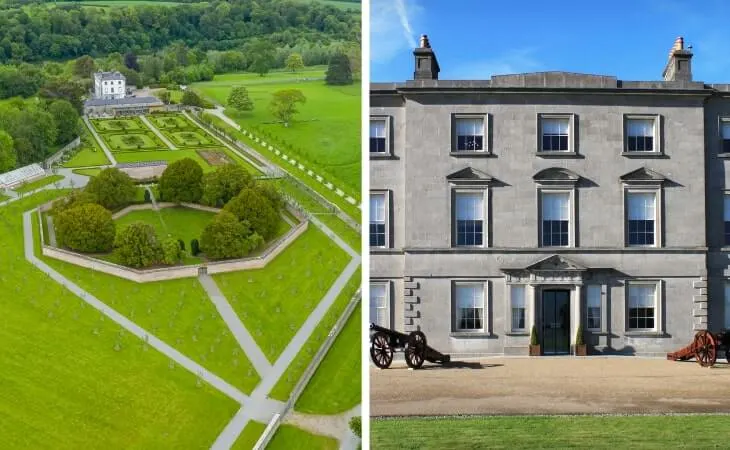
Photos via Shutterstock
The Battle of the Boyne Visitor Centre is just outside of Drogheda (10-minute spin) and it’s here that you’ll be immersed in the story of the Battle of the Boyne.
The story is brought to life via exhibitions, visual displays, unique features and a short film. There’s also a lovely walled garden that you can stroll around along with several walking trails.
Stop 17: Brú na Bóinne
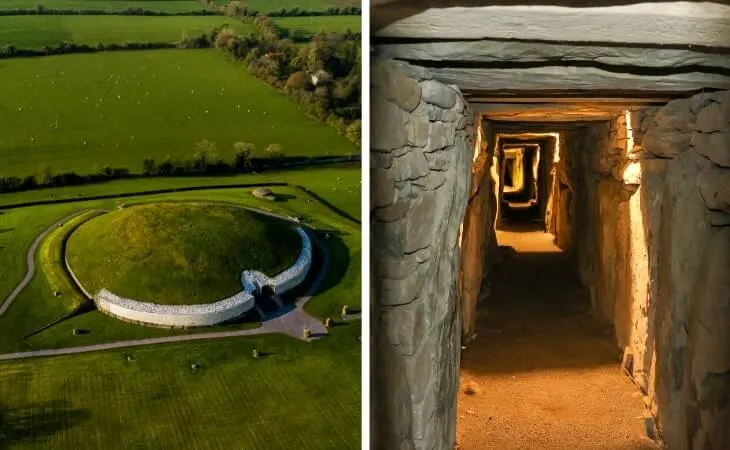
Photos via Shutterstock
Our last stop is Brú na Bóinne – one of Ireland’s most popular attractions, and it’s a 10-minute drive from the Battle of the Boyne Visitor Centre.
Here you will find three majestic passage tombs dating back to 3,000 BC. The passage tombs of Newgrange and Knowth can only be accessed from Brú na Bóinne Visitor Centre, while Dowth passage tomb can be reached by car.
This World Heritage Site was used in ancient times for burials and ceremonies and is home to the largest megalithic site in all Western Europe!
FAQs about the Boyne Valley Drive
We’ve had a lot of questions over the years asking about everything from ‘Can you cycle it?’ to ‘What are the main stops?’.
In the section below, we’ve popped in the most FAQs that we’ve received. If you have a question that we haven’t tackled, ask away in the comments section below.
Is the Boyne Valley Drive worth doing?
Yes – 100%. The Boyne Valley is home to countless attractions, and this drive takes you to the very best of them, in one long swoop.
How long is the Boyne Valley Drive?
The entire length of the drive is 190km (120 miles). You can break this up into chunks, depending on how much time you have.

